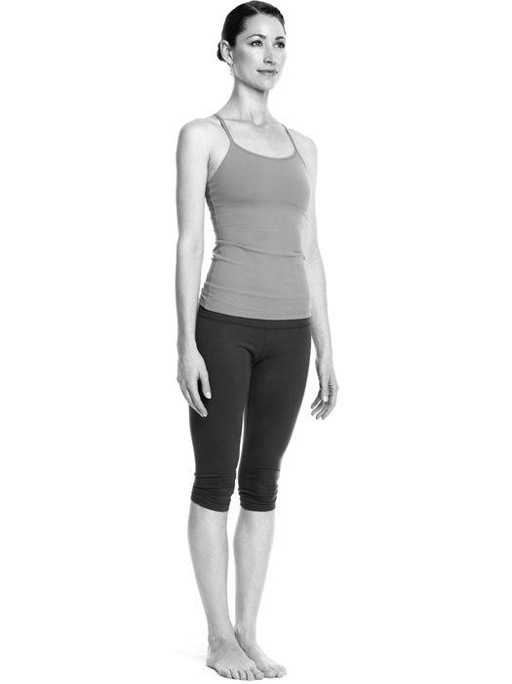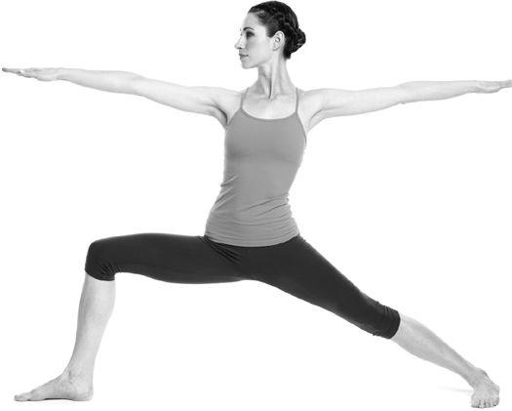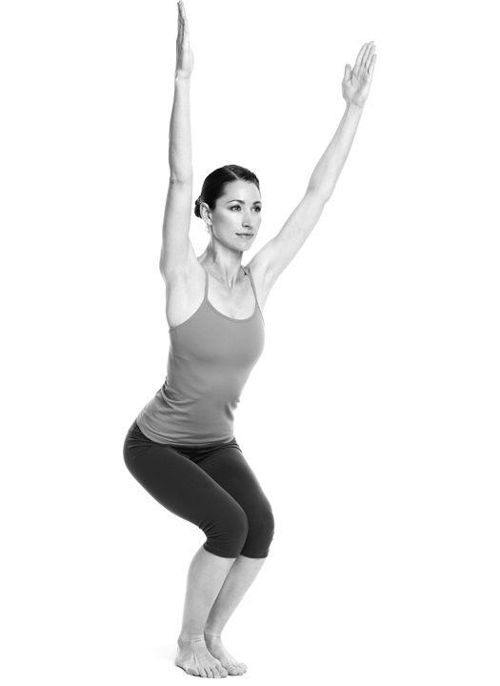Yoga Cures: Simple Routines to Conquer Over 50 Common Ailments and Live Pain-Free (5 page)
Read Yoga Cures: Simple Routines to Conquer Over 50 Common Ailments and Live Pain-Free Online
Authors: Tara Stiles
Tags: #Health & Fitness, #Yoga, #Pain Management

shortened, back out of the pose, or rest until you can breathe deeply again. Child’s pose is a great place
to take a breather.
CHILD’s POSE
Gently come onto all fours. Relax your hips and sit back on your heels. Rest your forehead on the ground and
breathe deeply into your back. Stay here for five long, deep breaths.
file:///C|/...ures%20Simple%20Routines%20to%20Conquer%20Mlments%20and%20Live%20Pain-Free%20-%20Stiles%20Tara/index.html[5/29/2012 10:54:20 PM]

HEALTHY AND SUPPORTED WRISTS
Hands and Knees Wrist Release
A lot of yoga poses are spent bearing weight on your arms, get into the habit of warming up your wrists before you practice to avoid pain and injury. If you spend a lot of time working at a computer it’s good to do this exercise daily to maintain healthy wrists. When you are practicing, spread the fingers wide like you are digging into wet sand. You want to give your hands a strong and steady foundation.
file:///C|/...ures%20Simple%20Routines%20to%20Conquer%20Mlments%20and%20Live%20Pain-Free%20-%20Stiles%20Tara/index.html[5/29/2012 10:54:20 PM]

FIND YOUR FEET
Standing
Your feet are your foundation in a lot of the poses. Make sure you stand firm on them! Stand at the top of your yoga mat. Feet are parallel and slightly apart, under your hip bones. Your hip bones aren’t at the outside of your hips so make sure your feet aren’t too far apart. You can check by placing two fists between your feet. That’s about the width of your hip bones. Close your eyes and bring your attention to your breath. Lengthen and deepen your inhales and exhales and continue breathing at this nice, slow pace for five full breaths. Gently open your eyes.
file:///C|/...ures%20Simple%20Routines%20to%20Conquer%20Mlments%20and%20Live%20Pain-Free%20-%20Stiles%20Tara/index.html[5/29/2012 10:54:20 PM]


KNEES OVER TOES
Warrior 2
This alignment rule is good for the health of your knees and other joints. In warrior poses and most standing poses you want to make sure your knees are over your ankles, not rolling in or out, or moving past your toes. You may not feel strain in your knees right away if you compromise your alignment, but over time misalignment causes wear and tear. So make sure to always check the alignment of your knees over your ankles.
LENGTHEN THE SPINE
file:///C|/...ures%20Simple%20Routines%20to%20Conquer%20Mlments%20and%20Live%20Pain-Free%20-%20Stiles%20Tara/index.html[5/29/2012 10:54:20 PM]

Bridge
Yoga is about creating space in the body. Most poses involve the spine whether they are forward bending, twisting, or back bending. Always consider creating more space between each vertebra and the next, rather than rounding and crunching the spine. When arching, the tailbone is rooted down and the chest lifted. Try to avoid crunching and sinking into the lower back. Make sure to extend evenly through your entire spine, from the back of your neck
through your tailbone. Lengthening the spine will ward away a lot of back problems.
DON’T GRIP YOUR MUSCLES
Chair
file:///C|/...ures%20Simple%20Routines%20to%20Conquer%20Mlments%20and%20Live%20Pain-Free%20-%20Stiles%20Tara/index.html[5/29/2012 10:54:20 PM]
Your muscles will do what they need to do to be in a pose. There is no need to grip your muscles to hold a position.
Engage the muscles that you need for each pose and rest what you don’t need. You’ll find your body can work much more efficiently when you avoid gripping and flexing your muscles while moving. And don’t worry, you are still getting all the workout you’ll need. No flexing required.
Always Remember to Breathe
After you’ve gotten your alignment down, don’t forget to come back to the breath and feel each pose
and movement. When you are this focused on the breath, it becomes the guiding yoga pose. All the
movements come out of the breath like a wave. Your body takes on a lightness and a sense of
efficiency and ease and your mind calms. Whenever you lose track of the breath, simply guide your
attention back. The breath will always be there waiting for you to follow it.
A good guideline for breathing is to expand, lengthen, and strengthen your body with each breath in,
and release, ease, and relax your body with every breath out. Moving through challenges becomes far
easier when you can get your breath working for you this way. To have lasting strength, we need to
begin by embodying flexibility. When we hold our breath we tense. The body becomes stiff, the mind
goes into frazzled mode, and things can spiral out of control. Deep breaths allow the body to work
efficiently, the mind to focus in a calm way. When you hold your breath and attempt to push through
the movements, not much happens except a lot of forcing, building up tension and stress that can lead
to a habit of forcing and injury. When you breathe with ease the poses happen smoothly, and when they
don’t you learn the needed patience that allows you to breathe through the tension.
What else do you need to remember before you get started? It’s all about taking CARE…
TAKE “CARE” OF YOURSELF; THE YOGA WILL FOLLOW
If you have clarity, attention, relaxation, and ease, you’ll be on your way to feeling great with yoga.
Remembering these four qualities, remembering to CARE, can help you through your practice every
step of the way.
Clarity.
Know what you are doing and why. Are you practicing to heal from a specific ailment, to de-
stress, or something else? Your reasons might change daily, but considering what they are is useful.
Forming an intention and approaching your practice with clarity will get you started—and keep you
pointed—in the right direction.
Attention.
By now you know, attention is the foundation of yoga. Keeping your attention on your breath during meditation and yoga (moving meditation) takes practice. Whenever your attention wanders, just
simply guide it back.
Relaxation.
It’s interesting that we have to learn how to relax. We spend a lot of our lives tensing up in preparation to “do battle” each day, with our families, bosses, or our to-do list. When we release the
tension, step away from the fray, we have more room in our bodies and minds. And yes, again, it’s all in
your breathing. Deep, attended breaths lead directly to relaxation.
Ease.
Finding an ease in your body and mind is essential in yoga. When your breathing gets shorter and faster, know that you can always bring it back to full and deep. Again, your body and mind will follow
your breath. So control it, rather than the other way around. And again, you don’t “grip” it, you just
file:///C|/...ures%20Simple%20Routines%20to%20Conquer%20Mlments%20and%20Live%20Pain-Free%20-%20Stiles%20Tara/index.html[5/29/2012 10:54:20 PM]
attend to it … the lungs will open up all on their own.
Want to find out what else yoga can help with when practiced regularly? Check out the next chapter: it’s
a look at the science and at some real people who’ve been helped by doing yoga. Do you need to read it
before doing the cures? No … and yes. No, because the poses work when you do them. Period. Yes,
because with a clear understanding of why you are doing anything, you get more, you get further, and
you get there faster.
THE POCKET YOGA GUIDE: Five Steps to Always Remember
Step 1. Become an observer
It’s quite interesting to step outside and watch yourself. You will learn something new every time. Observing your actions takes you out of reacting mode. You gain more time to see what’s going on and adjust accordingly.
Step 2. Watch, don’t judge
While doing this, remember not to judge. You can learn a lot more about your habits and behaviors if you can
simply observe without judgment. This doesn’t mean you abandon all ability to discern good from not good! It just means you get to take a break from instant reactivity, just to watch.
Step 3. Wait
The reason it’s called practice is because it requires practice. Every day you keep at it. At first, it may not seem like much of anything is happening. But if you keep at it your body will open and strengthen and your mind will calm and settle. Have patience with yourself. Yoga doesn’t always work on the schedule you may want it to. Allow time for its lessons to simmer. Enjoy the process. Remember life is a work in progress and you’re always right in the middle of it … so that progress is sometimes hard to see.
Step 4. Keep it up
If you feel like giving up, because nothing good seems to be happening, keep practicing. Things are changing in your body and mind. Trust the process. Trust yourself. Neither will let you down.
Step 5. Don’t worry
There is nothing to worry about. You are right where you need to be and you have all the tools you need.
When you calm your mind, everything opens up. Stress melts away, worries dissolve, the body gets crazy healthy, and your energy levels skyrocket. The only thing standing in your way is your own limited thinking about yourself.